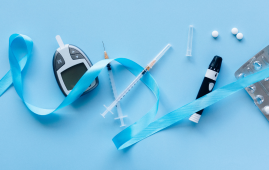

The fight against cancer continues despite decades of study and tens of billions of dollars spent on research and treatments globally.
Conventional therapies like surgery, radiation, chemotherapy, and medication have helped patients make progress. However, these treatments, which are frequently expensive and painful, can have negative adverse effects. Cancers that have been defeated in one location may return elsewhere, and healthy body cells may be negatively impacted.
Doctors can now implant tiny drug delivery systems that more accurately target infected areas into human tissue thanks to advancements in technology. However, difficulties with permeability and biocompatibility still exist.
Now, scientists at Shanghai’s Fudan University claim to have a more effective strategy to fight cancer.
Fan Zhang and Yongyao Xia revealed their findings in a paper that was just last week published in the journal Science Advances. They claimed that a self-charging implantable battery that consumes oxygen can target and fight cancer cells.
Hypoxia, or reduced oxygen levels, is a characteristic of tumor cells. This has given medicine a desirable aim and a distinct objective: Create a drug delivery system that searches out low-oxygen environments and adds cancer-fighting drugs to it.
Previously, this strategy had only moderate results because solid tumors’ levels of hypoxia were insufficient or unbalanced. However, Zhang and Xia claimed that their strategy focuses more on the cell’s surroundings than the cell itself.
“Using implantable devices to regulate tumor microenvironment ‘in situ’ may be a more effective way for cancer therapy,” they said.
They knew that if they could increase the degree of hypoxia, a tumor site would be more easily identifiable. So they designed a self-charging salt-water battery that can “persistently regulate oxygen content … in a tumor microenvironment.”
The battery is a component of a two-stage strategy for tumor eradication. While tumor-killing medications are used, it heightens and maintains the condition of hypoxia in order to detect cancer cells in low-oxygen areas. There is little to no effect on healthy, oxygen-rich cells by restricting drug application to low-oxygen areas.
The battery/drug strategy totally eliminated tumors in 80% of the mice in a small study.
Zhang claims that the battery inside a tumor cell can go without stopping for more than 14 days.
“This work is a crossover study between battery technology and biotherapy,” Xia said. “[It] not only provides a new treatment method for anti-tumor therapy but also creates a precedent for batteries in biomedical applications.”
The authors of the report say despite early impressive results, more research is needed. Although no serious side effects were noted in the mouse study, standards for humans are stricter. Compatibility with human tissue must still be confirmed. But the researchers say the technique holds great promise for application in other devices.
“The battery components are biocompatible, which minimized the harm of battery implantation,” they said. “Moreover [there is] great potential to develop other therapeutic devices, such as electrochemiluminescence, wearable devices, interventional therapies, inflammatory microenvironment regulation, and electric nerve stimulation.”
more recommended stories
 Phage Therapy Study Reveals RNA-Based Infection Control
Phage Therapy Study Reveals RNA-Based Infection ControlKey Takeaways (Quick Summary) Researchers uncovered.
 Safer Allogeneic Stem Cell Transplants with Treg Therapy
Safer Allogeneic Stem Cell Transplants with Treg TherapyA new preclinical study from the.
 AI in Emergency Medicine and Clinician Decision Accuracy
AI in Emergency Medicine and Clinician Decision AccuracyEmergency teams rely on rapid, accurate.
 Innovative AI Boosts Epilepsy Seizure Prediction by 44%
Innovative AI Boosts Epilepsy Seizure Prediction by 44%Transforming Seizure Prediction in Epilepsy Seizure.
 Hypnosis Boosts NIV Tolerance in Respiratory Failure
Hypnosis Boosts NIV Tolerance in Respiratory FailureA New Approach: Hypnosis Improves NIV.
 Bee-Sting Microneedle Patch for Painless Drug Delivery
Bee-Sting Microneedle Patch for Painless Drug DeliveryMicroneedle Patch: A Pain-Free Alternative for.
 AI Reshapes Anticoagulation in Atrial Fibrillation Care
AI Reshapes Anticoagulation in Atrial Fibrillation CareUnderstanding the Challenge of Atrial Fibrillation.
 Hemoglobin as Brain Antioxidant in Neurodegenerative Disease
Hemoglobin as Brain Antioxidant in Neurodegenerative DiseaseUncovering the Brain’s Own Defense Against.
 Global Data Resource for Progressive MS Research (Multiple Sclerosis)
Global Data Resource for Progressive MS Research (Multiple Sclerosis)The International Progressive MS Alliance has.
 AI Diabetes Risk Detection: Early T2D Prediction
AI Diabetes Risk Detection: Early T2D PredictionA new frontier in early diabetes.

Leave a Comment